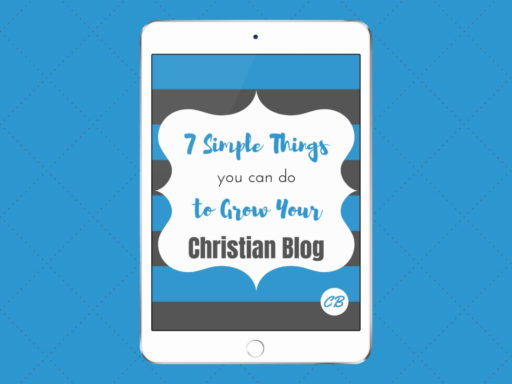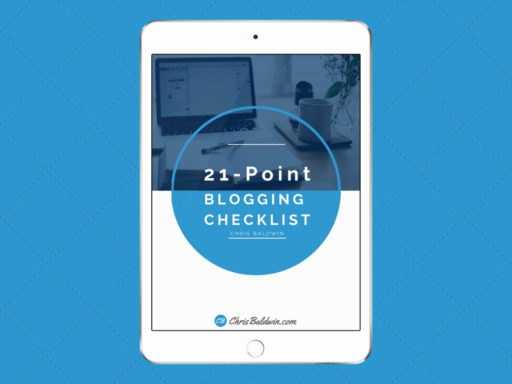Do you feel called to start a Christian Blog? Starting and growing a successful blog is not a simple task, but it doesn’t have to be difficult. I can break it down for you and teach you the step-by-step method to starting and growing your Christian Blog. Here’s the 10 steps to starting and growing your Christian Blog.

Step 1: Write Down Why You’re Starting a Christian Blog
First, grab a sheet a paper and write down why you want to start blogging. Knowing why you want to blog will help you persevere through seasons where your blog is not performing like you wished.
Those times will come, it happens to everyone. Having hope and a purpose is the best way to make it through those seasons. I recommend determining why you want to blog at the very beginning. Plus, it’ll get you pumped…which will lead to a fantastic start.
There are several reasons you might want to start blogging. Maybe God has called you to blog and share your experiences with others. Maybe you have a passion that you want to share with the world. You could even start blogging just to learn more about a topic yourself.
You can have more than one reason. Maybe you want to tell your story, help others, and earn some extra income. Whatever the reasons are, write them out and know why you’re starting your blog.
If you need help, check out this other post I wrote titled, 7 Reasons You Should Start Blogging.
Step 2: Pick Your Niche
Next, pick your niche. A niche is simply the topic of your blog. Take a moment to decide what you’re passionate about…write it down. When you try to write to everybody, you’ll be writing to nobody. This is why you need to narrow your audience.
The riches are in the niches. Narrow down your audience as much as you can. I blog primarily to help other Christian Bloggers. I’m not blogging about roommates dog, how to plan to the best vacation, etc.
I focus narrowly on helping Christian Bloggers create, grow, and leverage their online platform for the Kingdom.
What is your focus? Are you helping married couples? Do you want to do a devotional style blog where each post is a Christian devotional on a certain topic? Find your niche…and stick to it…and you’ll find your audience.
Just because you’re a Christian blogger doesn’t mean that all the post have to be devotional or use scripture. There are three different types of Christian blogs.
First, there is the traditional Christian Blog where it is primarily devotional style posts. Second, you could blog through what I call a faith lens. Where you approach a topic through the lens of your faith. Finally, there is the hybrid Christian Blog. This is where you do devotional style posts and write through your faith lens.
My blog, ChrisBaldwin.com, is a hybrid Christian Blog. If you want learn more about picking your niche and writing through a lens of faith, check out my article, How to Write a Christian Blog Through a Lens of Faith.
Step 3: Write Down Your Blog’s Purpose
Just like how you wrote down the reasons you’re starting to blog, write down the purpose of your blog. For example, mine to to help Christian bloggers create, grow, and leverage their platform for the Kingdom.
Start with your niche and ask yourself, “What problems am I going to solve for my readers?” Make a list of problems your ideal reader faces. This will come in handy when you start creating content because not only does your over all blog need a purpose…so does each piece of content.
Every post should help your readers solve a problem. This post is to help Christian Bloggers start and grow their very own blog. Every time you draft a post, asks yourself, “Does this piece of content pull readers closer to the purpose of my blog or push them away?
If you need help determining your blog’s purpose, I’d recommend having a quiet time and pray about it. By spending time with God in prayer concerning your blog, you get to partner with the ultimate Creator in launching and growing your blog.
I wrote an article titled, How a Quiet Time Transforms Your Life, Blog, & Business. Check it out and consult with God on the purpose of your blog. Keep a notepad next to you to write down any idea you might have during the quiet time.
Step 4: Pick a Domain Name for Your Christian Blog
Next, you finally get to pick your domain name. Your domain name is how people will will find you. You want to find a good .com name…one that looks professional.
You can either choose a name based on the purpose of your blog or you can start developing a personal brand where you use your own name as your domain name.
Mine is a personal brand and my website is ChrisBaldwin.com.
You can use tools like the one from Bluehost below to check if a domain is available.
Take some time to think about this step…don’t just pick the first domain that comes to you. Your domain needs to be easy to remember and, if you’re not building a personal brand, convey the purpose of your blog.
When you set up your domain name, you’ll also need to get hosting. I recommend Bluehost for both your domain name and to provide hosting. I’ve used them since the beginning of my website and love them.
Plus, when you set up a Bluehost account you also get free domain name registration.
Use the tool below to check if the domain name you want is available. If its not available, keep thinking and praying about it.
A good strategy is to make a list of 5 to 7 domain names you’d like to use. Prioritize them from the one you like the most to the one you like the least…but still like. Then, use this tool from Bluehost to check the availability of each one.
Step 5: Set Up Hosting & Install WordPress
This step and the last one really happens at the same time. For step 5, sign-up for hosting and install WordPress. Once WordPress is installed, you can pick out a theme.
The theme is the way your site will look and operate. There are a ton of free themes to choose from as well as some great premium themes as well.
When choosing a hosting company, I recommend picking someone you can trust and who has 1-Click WordPress Install. This makes it very easy to install WordPress on your site.
You merely have to check sign-up for hosting, select your domain name, and then click install WordPress. WordPress will then be installed and you’re ready to go.
Bluehost is a great option and the one I recommend. They offer 1-Click WordPress Install and a free SSL Certificate with every account. Plus, their 24/7 customer service is amazing.
Additionally, their hosting plans start at only $3.95 per month.
If you want to learn more about why I recommend self-hosting with Bluehost instead of using WordPress.com, check my article Which WordPress Should You Use. This article also goes more in-depth on themes, plugins, and domain names.
At the end of the article, I show you how to migrate your existing WordPress.com site to a self-hosted site.
I know this seems like a lot of work, but in reality it will not take that much time and doing the work at the beginning will benefit you greatly your site begins to grow.
Step 6: Set Up Your Social Media Accounts
Creating your blog is only part of the equation, you still need to market your blog. You need to get your blog in front of your ideal readers. One of the best ways to do this is through social media.
There are several social media platforms you can use to market your blog. I recommend focusing on one or two of them at first. If you try and do all of them, you will wear yourself out trying to connect and grow all your social media accounts.
Pick the social media that your ideal readers use. If your ideal readers don’t use Twitter, it will be pointless to start advertising your blog on Twitter.
Also, try and keep all your social media accounts under the same handle. What I mean is try and use the same user name for all the accounts. It could be your personal name if you’re building a personal brand, or it could be the name of your website.
For example, all of my social media accounts are under TheChrisBaldwin. Let’s break down some of the social media accounts you can use.
First, Instagram. Instagram is great for bloggers. You can promote your blog in stories and also through posts. When using Instagram, use hashtags to find your ideal readers. Instagram makes it easy to do this. You can also do lives on Instagram to promote your latest blog posts and allow readers to ask questions.
Follow me on Instagram. https://www.instagram.com/thechrisbaldwin
Next, Facebook. Setting up a Facebook page for your blog is a great idea. I do Facebook lives once a week to discuss my latest post and answer any questions my readers may have. I also use Facebook advertising to find and introduce new ideal readers to my blog.
You can like my facebook page here. https://facebook.com/thechrisbaldwin
Third, Twitter. Honestly, I don’t use Twitter as much as Facebook and Instagram. I do; however, like having a box that a “Click to Tweet” in my blog post. Therefore, I would recommend Twitter for that reason. It’s another way for your ideal readers to share your post.
Follow me on Twitter. https://twitter.com/thechrisbaldwin
Finally, Pinterst is a great platform for bloggers. You can create pins that link to your blog posts. Unlike other social media, Pinterest works like a search engine. People search for a topic and Pinterest provides pins related to that topic. Therefore, Pinterest is a great platform to increase traffic to your blog.
Check out my Pinterest page. https://www.pinterest.com/thechrisbaldwin/

Start with the social media platforms your ideal readers are using. Do your best to keep the same user names for each of these accounts. Notice above how all of my accounts are TheChrisBaldwin.
You’ll be using these accounts to place your blog posts in front of your ideal readers…don’t expect them to find you. You must go to them.
Step 7: Start Your Email List
Your email list is the most important aspect of your blog. I know that sounds a little crazy to say, but growing your email list is what separates beginners and professionals.
Growing an email list will benefit you in three ways. First, you can notify your list of new content each week. This will keep people coming back to your blog and increase traffic.
Secondly, you will be cultivating relationships with the people on your list. You can ask questions, get to know them, etc. This will not only help you when you decide to monetize your blog, but it will also help ensure you are creating the content your readers need.
Finally, If you ever want to monetize your blog, you’re going to need an email list. When you decide to write that ebook, create that course, or use affiliates…your email list is your warm audience. They are the ones like to buy your ebook, enroll in your course, or purchase one of the products you recommend.
Building an email list takes time…that’s why I recommend starting from the very beginning. This way you can be growing your list as you grow your blog.
You will need an email service provider that is not gmail. A company that allows you to segment your audience, use tags, and create automated sequences. The only email service I recommend is ConvertKit.
You need someone you can trust and who knows all about list building. Convertkit is email marketing made by creators…for creators. They’ll help you get started with growing your own email list.
I use and love ConvertKit. Click below and sign-up for their free trial.
Step 8: Write Your First Post
Now its time to write your first post. For your first post, I’d recommend writing an introductory post. This is simply a post explaining who you are, why you’re blogging, and the purpose of your blog.
This will be a post where your readers can come to and know if your blog is for them or not. Remember, you’re not writing for everyone. You’re writing to your niche.
In this post, there are three things you should include. First, let your readers know what your blog is about. If its about Christian marriages, tell the reader your blog focuses on helping married Christians.
If your blog is about a hybrid Christian blog, let the readers know you’ll be publishing both Christian devotionals along with post concerning [insert your niche topic here].
Next, your introductory post should include how often you plan on publishing new content. I would recommend stating with at least once a week.
Consistency is more important than quantity. If you don’t think you can maintain two to three posts a week, then don’t try it…work your way into it, but more on that in the next step.
Finally, your post needs to include how readers can connect with you. Link your social media handles and place an opt-in form for your email list. This way readers can follow you on Facebook, Instagram, etc or they can join your email list.
When you finish writing this post, give it a day and then go back and edit. Once you’ve edited the post…hit that publish button…Your blog is now up and running! Congratulations…but there’s still more to do if you want your audience to grow.
Step 9: Consistently Publish New Posts
You grow a loyal audience by publishing good consistent content to a niche audience. Publishing consistently is important because your readers will learn your schedule. They will come looking for your posts…if it is there you earn trust…if it’s not there you lose trust.
Over time that trust builds and they become loyal ideal readers. Attracting an audience of loyal ideal readers is why you publish consistently. Developing a blogging habit is how you publish consistently.
I’d recommend publishing at least once a week. Pick a day and stick to you. You can add more days later if you decide to publish more than once a week. What’s important is you’re earning your reader’s trust and you’re developing a blogging habit.
Mind Mapping
Here’s a tactic you can use to create an endless supply of blogging topics…mind mapping. Mind mapping is when you place one topic in the middle of page and then branch off of that topic with sub-topics.
Start by writing out your blog’s purpose in the middle of the page and then branch off with everything your readers need to know to achieve your blog’s purpose. Then you can branch off those sub-topics as well into individual blog posts topics.
Here’s an example. The purpose of my blog is to help Christian Bloggers create, grow, and leverage their Platform for the Kingdom. I’d write that in the middle. Then I’d branch off.
Maybe the next layer of branches could be creating, growing, and monetizing. Then off the creating branch I’d write these:
Each one of those then becomes a blog post. Read my article, How to Develop a Blogging Habit, to learn the 4 steps to develop a bogging habit. The article also addresses mind mapping and creating your blogging schedule.
Step 10: Market Your Christian Blog
Finally, you’ve made it to Step 10: Market Your Christian Blog. Your journey doesn’t end with publishing consistently, you also need to market consistently.
You need to develop a marketing strategy. A strategy that will place your blog in front of your ideal readers. Therefore, when you publish your post, send it to all your social media accounts with a description of who the post is for and why they should read it. By doing this consistently, you’ll be attracting your target ideal readers.
I’d also recommend doing a Facebook or Instagram live discussing your new post. This is a great way to allow your readers to interact and get to know you. I do a Facebook live once a week where I discuss one of my posts that week and answer any questions.
Finally, send a link to your post to your email list. Let them know the post is up and what they can expect to learn from reading it…i.e. the problem your post solves. Start doing this even if you have a very small list. You need to get in the habit of emailing your email subscribers and, likewise, they’ll get in the habit of reading your emails.
Therefore, even if your mom is the only person on your list…email her weekly and let her know (1) you have a new post and (2) why she should read it.
If you decide to publish multiple times during the week, either segment your email list or send a digest at the end of the week. As of this writing, I send a digest email each week detailing the content published and the problem it solves.
If you want to use my marketing workflow, get my 21-Point Blogging Checklist. This is my ultimate checklist designed to help you consistently write, optimize, and market every post you write. You can get it for free here.
Conclusion
Starting and growing your Christian Blog is not simple…but it doesn’t have to be difficult. Go through these 10 steps one by one and you’ll not only start your Christian Blog, but will be growing your Christian Blog as well.
Remember, it takes time to grow your blog, so give yourself some time. Growing your blog is something you’ll need to work on each day, but trust me…it will be worth it.
Feel free to steal my workflow, get my 21-Point Blogging Checklist. It’ll help you consistently write, optimize, and market every post you write.
Get the FREE Checklist
Question: What’s the purpose of your Christian Blog? Let me know in the comments below.











Excellent Write up! My blog is christianintrovert.com and its focus is to teach the bible and encourage Christians that are more introverted and feel they are insignificant when it comes to doing Gods work. Many times we feel like we don’t have the skill set to motivate others or we don’t feel like our work is noticed because it is usually in the background. Our quiet nature often feel like a hindrance. I want to show others that it is not a hindrance but a strength. We just have to know how to use it.
Come on! That’s awesome! “Our quiet nature often feel like a hindrance. I want to show others that it is not a hindrance but a strength. We just have to know how to use it.” That is so good! It’s clearly identifies your niche, points to a problem, and your solution. I love it. I’ll definitely be checking out your site.
Thanks. I hate to admit I started it in 2017 and didn’t do much with it. But I made a commitment for 2019 to buckle down and give it the attention it deserves.
I checked it out…it looks good! I’m happy to hear you’re recommitting to it, most people don’t and that’s why they fail. Most give up the day after it’s no longer perfect. So, great job on jumping back to it. I’m excited to see what all you do in 2019!
Thanks for the tips. I just started blogging (onelegforchrist.com) and my goal is to encourage and challenge people in their walk with Christ.
Congrats on starting your blog! I’ll have to check it out.
congrats!
Thanks for this post, I was feeling kind of lost before I read it.
You’re not alone. We’ve all felt lost at some point during our blogging journey. I’m glad you enjoyed the post.